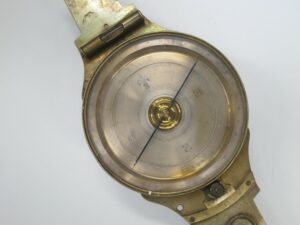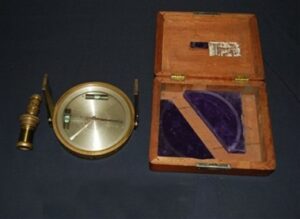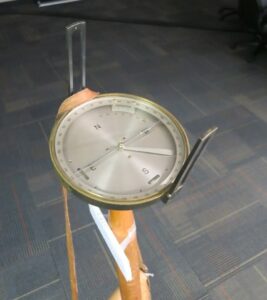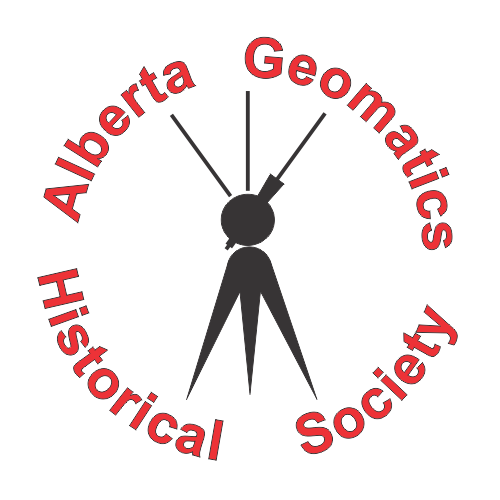
16. Not Quite Redundant – The Surveyor’s Compass
By Gordon Olsson
In Article 2 of this series, it was explained that the difference between a surveyor’s compass and a circumferentor was that a surveyor’s compass was an American term and circumferentor was a British and Canadian term. Two circumferentors, made in Canada, that are in the survey artifact collection, are described in Article 2.
It was common to survey boundaries using surveyor’s compasses and circumferentors in the 19th century. In Western Canada, their use diminished with the advent of the Dominion Lands Survey as bearings were to be astronomic (See Article 5 – Surveys were to be Astronomical). As time went on, eventually all surveys in Canada were based on astronomic bearings. In Alberta in the early days, it is very likely that the surveyor’s compass was used for reconnaissance surveys and route finding and may have been used for early boundary surveys. One of the donated surveyor’s compasses in the collection may have been used by A.G. Stewart ALS#078 whose career goes back to just after the turn of the 19th century. In land surveying, compasses are still used to find survey posts from bearing trees and they can be used to locate buried iron survey posts. Despite GPS, occasionally they may also be used with a map for route finding,

This compass was manufactured by W.& L.E. Gurley, in Troy, NY. It is very old and missing its vertical sights. The company that made it, W. & L.E Gurley, was established in 1852 and continued operation until 1968. The compass likely belonged to A.G. Stewart ALS#078. A.G. Stewart established a private survey practice in Edmonton which evolved into the firm Stewart, Weir, Stewart, Watson, and Dixon.
Donated by Steve Dixon, WSP Geomatics (successor to Opus, Stewart, Weir)
ALSA 2018.01.08

Surveyor’s Compass made by John Davis & Sons; Derby Ltd. The company, John Davis & Sons, was founded in 1835. It changed names a few times in its history but had the name ‘John Davis & Sons, Derby Ltd. from the 1900s to the 1960s, giving some indication of the compass’ age.
Donated by Steve Cherwonick ALS#238.
ALSA 2010.06.05
Tripod ALSA 2010.06.01

Surveyors Compass, W. & L. E. Gurley, Troy NY.
Donated by C.H. Weir ALS#164.
ALSA 2007.27.07

Surveyor’s Compass made by Short and Mason. A similar compass is shown in a 1929 Edition Tycos (Taylor Instrument Companies) catalogue. Ken Moyer who donated it worked from 1960 to 2005 for several survey firms in Alberta and British Columbia as a drafter and calculator.
Donated by Ken Moyer
ALSA 2016.05.02

D.W. Brunton Pocket compass made by Wm Ainsworth of Denver, Colo. D.W. Brunton is the name of Canadian Geologist D.W. Brunton who patented it in 1894. A unique feature of the compass is the ability to measure slope angles.
Donated by C.H. Weir ALS#164.
ALSA 2007.28.01
Sources of Information:
- GPI Gurly Precision Instruments, History: http://www.surveyhistory.org
- Science Museum Group, Collection, John Davis and Son (Derby) Limited.
- The Brunton Company: https://www.brunton.com/
Author: Gordon Olsson, ALS (Hon. Life)
February 21, 2022
Copyright 2024 © Alberta Geomatics Historical Society
